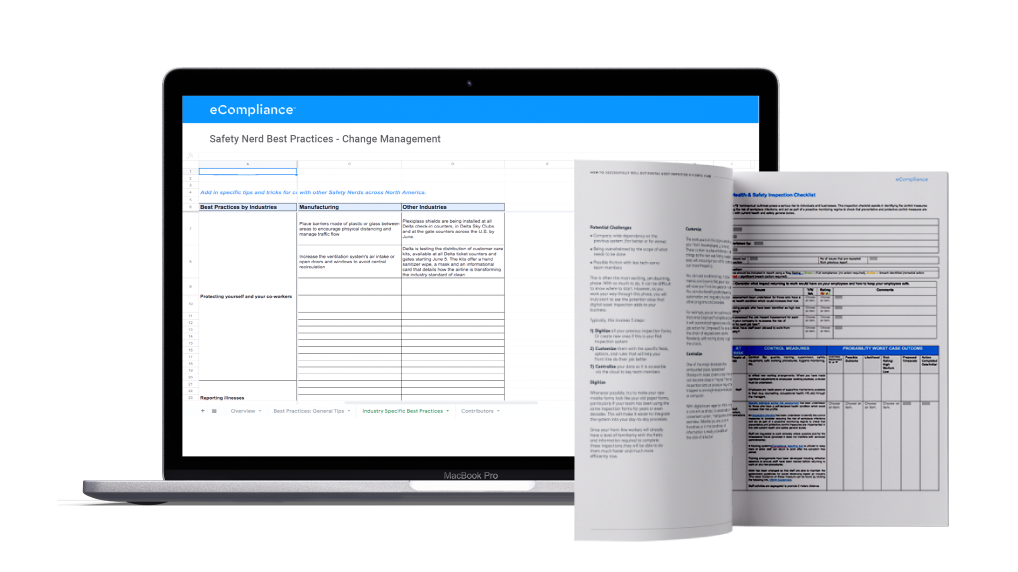
Share this Post
PUBLISHED
July 14, 2020
WRITTEN BY
Dina Adlouni
The year 2020 has been unpredictable, to say the least. COVID-19 has demanded all safety champions rise to the challenge in order to execute the best possible method to ensure all workers, whether off-site or on-site, are safe both physically and mentally. With an entirely new playing field to navigate, leaders around the globe have transformed their approach to protect their teams and ensure business continuity.
With much to consider, we wanted to help you devise an approach which would not only make you feel ready to return to work, but confident. After speaking with other experts in the world of EHS across North America, here are some effective tactics to make your transition seamless.
1. Strong Leadership is Imperative
One key element to a positive return to work is strong leadership. The senior leadership team has an imperative role to play during this time and will set the tone and pave the way for the entire organization to follow.
Your people are your most valuable asset, so a top-down approach is necessary to ensure their safety. With a “COVID-19 Response Team” in place, you can begin to devise a plan which is both flexible and adaptable to new regulations and information that may arise. If you have multiple locations and sites, it’s also important to make sure your policies and protocols are aligned across your entire organization, by forming cross-functional teams. With a proper cadence in place to meet and discuss any new updates, your “COVID-19 Response Team” will always be on top of any challenges that may come your way.
Policies and documents you must consider updating, range from your site sanitization and reporting illness policy to your equipment sharing and on-site visitor policy. According to EHS Daily Advisor’s article OSHA Issues Compliance Guidance Regarding Reopening Amid COVID-19, personal protective equipment standard 29 CFR §1910.132, sanitation standard §1910.141, respiratory protection standard §1910.134, access to employee exposure and medical records standard §1910.1020, recording and reporting occupational injuries and illnesses, section 1904, and hazard communication standard §1910.1200, should all be highlighted and considered before reopening. COVID-19 questionnaires and checklists for employees and visitors is also a must.
Your dedication to safety and a commitment to all team members is also essential. As the old saying goes, “Good leaders, lead by example”, so let it start with yourself. Let your employees look to you as a pillar of strength and a source of support during this time, as your demeanor could make or break their sense of security.
Remember, ensuring a safe return to work is a journey which will take time, so don’t rush the process. Only when you have all the fundamental steps in place, can you move on to the next phase.
2. A Solid Infrastructure Must be Implemented
Building the proper infrastructure to deal with an ever-evolving environment, is key. It may be time to consider your health and safety system and on-site protocols.
With the latest advances in technology, this may be the perfect time to consider a digital platform to help reduce close contact of team members and unnecessary travel. If you have been using a paper-based system, you may have found it can be cumbersome and is filled with a range of touch points. Think about it. With daily inspections, pens and papers are shared between team members as documents are passed from the front-line to senior team members. This kind of system also lacks visibility. With a mobile-friendly electronic system, you will be able to pull up records and data in seconds, giving you complete insight into your entire organization. Additionally, you will eliminate the possibility of cross-contamination between workers and sites.
Now that you have a strong foundation, it’s time to move on-site. Consider your on-site and off-site locations for head office and front-line workers, and begin to take the necessary steps to ensure their safety. Consider if you are able to separate staff, allow for social distancing, etc. and begin implementing methods to do so. For example, make sure all desks are at least two meters a part in the office and make sure to take into account all pathways and high traffic areas such as hallways, bathrooms, and the kitchen to reduce the chance of contamination between workers. On-site, ensure you are able to separate your team where possible, and place plastic or glass barriers between them if necessary, to promote social distancing. Ensure hand washing and hand sanitizing stations are also available for all workers at all times.
It’s also very important to reduce all contact points, as we previously mentioned. Encourage your front-line not to share papers, tools, or equipment. For those in the head office, try to install touchless hand soap dispensers and faucets in the bathrooms, as well as automatic doors and no-touch garbage cans.
3. A Phased Approach is Necessary
Now that the office and worksite are structured to reduce the rate of infections, consider a phased approach when returning team members to work. If you choose, contact tracing may be a wise decision before bringing people back into the office or on-site to see who may have contracted COVID-19. This way, you can safeguard those who are coming back into the office are virus-free.
Depending on your organization, you can think about how many phases you would like to have when returning to work, but many have decided to move forward with three.
During phase one, allow senior leadership to return to the office, where applicable, if none are living with high-risk individuals or have to take public transportation. While in the office or on-site, leadership can ensure the proper infrastructure, which was established in the previous step, is working and the environment is safe. This entails all pathways, seating areas, meeting rooms, etc. are double checked for your team members. If any conflicts or difficulties arise, take this time to rectify them.
Phase two entails bringing back around 25% of your team. It’s important to make the decision optional and open to those who are willing to come back. This can be proposed to those who are not living with high-risk individuals, do not have to use public transit to get to work, and have not displayed any signs of COVID-19. Returning to work should never be mandatory, as the safety of your team always takes priority over production.
The final phase entails bringing back the remaining staff and those in the office who feel comfortable. During this time, you can also consider staggering schedules or alternating days of work, so not everyone is always in the office all at once. Working from home has proven off-site teams are not less productive and can accomplish a lot, so remember to leave this decision with your team and their respective managers.
4. Employee Empowerment Will Go a Long Way
Your employees are the heart and soul of your organization, and it’s important to empower them during this process. This has been an extremely challenging time for all of us, and according to our Safety Nerd Community, the more information and communication we offer, the better.
It comes as no surprise that the mental of health of several, off-site, on-site, and essential workers has been affected. It’s time to destigmatize the notion of poor mental health by highlighting it in your meetings and Toolbox Talks, through open and honest communication. Find out more about how leaders can play a pivotal role in positive mental health, with these words from our CEO and Founder, Adrian Bartha, in his article Mental Health on the Frontlines.
With knowledge comes power. Make it a point to give your team as much information as possible during this transition. If you haven’t already, create a resource hub or portal where all employees can access information and updates from your organization or governing body, and consider releasing weekly video updates from the CEO or senior leadership to keep everyone in the loop. Also, encourage all team members to get the proper training with COVID-19 focused eLearning courses, to keep them aware of all the precautions they have to take, before they set foot on-site.
5. Reinforce, Reinforce, Reinforce!
Only through regular reinforcement, can you ensure the safety of all employees. This is a team effort and responsibility, so make it a part of your safety culture to continuously remind all members of daily best practices.
According to Harvard Business Review’s article, 5 Tips for Safely Reopening Your Office, it is essential to introduce new everyday habits. This can be done with daily drills where employees are encouraged to carry out safe habits such as social distancing, sanitization, or simply acknowledging when these practices have taken place with “please and thank you”. For instance, if someone is keeping two meters distance, employees should be encouraged to thank the person for taking this precaution, so it becomes engrained as part of everyday behavior. Consider asking employees to also acknowledge the opposite when someone is not carrying out safe practices, to help reinforce this.
Planning a safe return to work can go over seamlessly, however if employees are not encouraged to take part in reinforcing habits with other team members, it will never be sustained over time.
In the end…
This may be a long road, but there is light at the end of the tunnel. With a positive attitude and a team effort, navigating this new reality will be seamless.
If you’re still struggling to plan your approach, check out “Your Return to Work Essentials” for a smooth return.

Return to Work Essentials
Keep your front-line safe as you return to the worksite with our
Return to Work Essentials.
